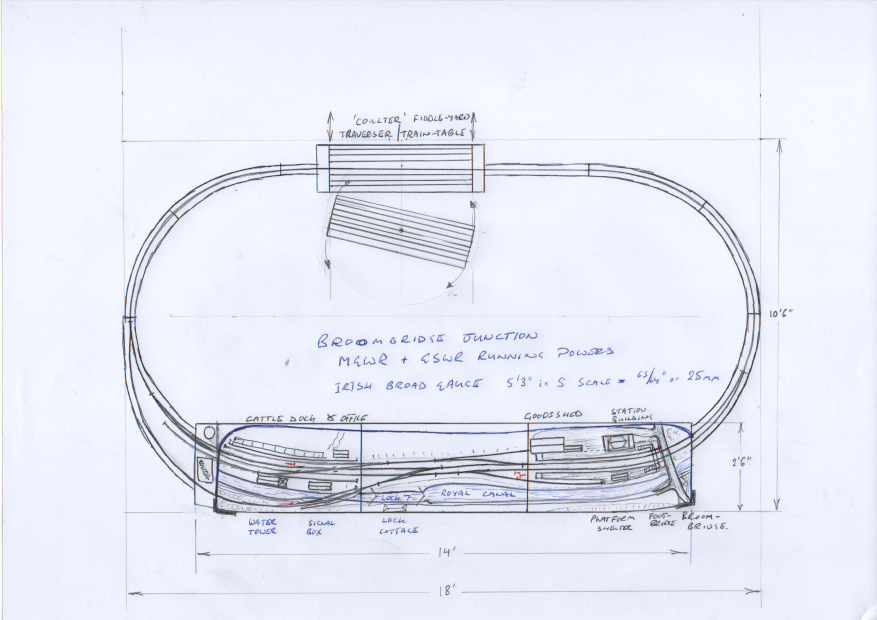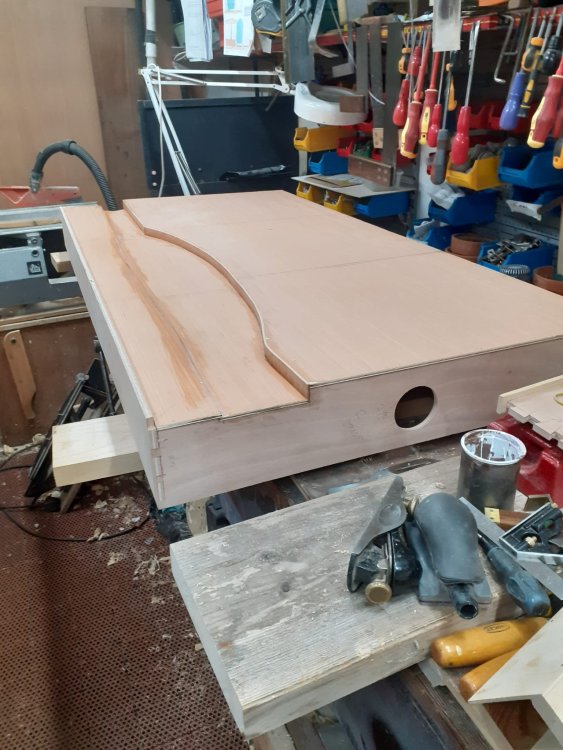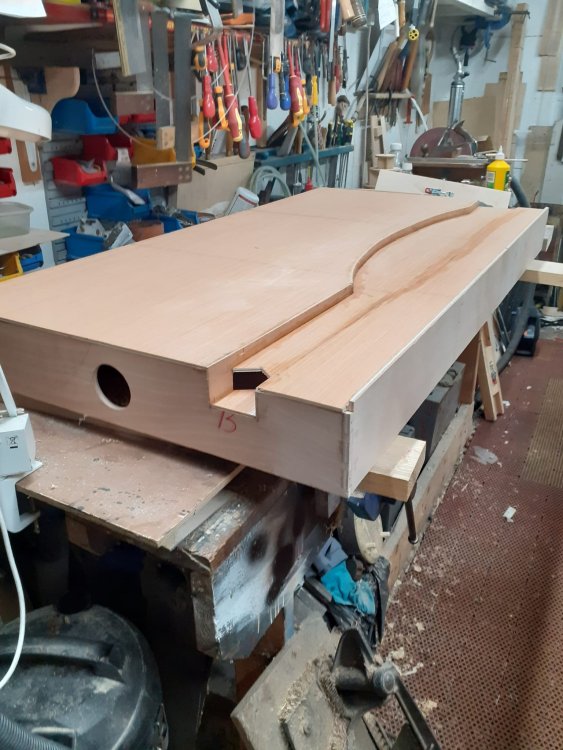
Broadstone
Members-
Posts
46 -
Joined
-
Last visited
-
Days Won
2
Broadstone last won the day on April 3
Broadstone had the most liked content!
Recent Profile Visitors
The recent visitors block is disabled and is not being shown to other users.
Broadstone's Achievements
-
Good point Rob. I'll have to twist your arm to build some stock and give you full running rights! I'm intending to illustrate Hamilton and his Wife on that famous occasion in some way. Even though it occured long before the railway was built.
-
Thanks again John, re-reading your post, I may well be setting a stiff time target. But I did recover the double slip and single slips from Kilbrandon and am re-using them on Broombridge, so that is going to save me a lot of time and trouble. And I have started drawing out the buildings so some progress has already been made. Intending it as an exhibition layout also focuses the mind!
-
As above to Gabhal, its 4'4" David, so in line with Fintonagh and Northport Quay as well as Arun Quay. I like looking 'into' these layouts and another advantage is being better able to control the sight lines and hide where the tracks disappear. I've long noticed how in real life trains disappear behind buildings and trees without the need for bridges and tunnels. The actual Broombridge will hide the trains going off to the right, whilst on the left the water tank and some trees will hide them as they pass through the backscene. Yes auto-couplings are 'satan's spawn' and I'm not sure any of them work 100%. I'm experimenting with Jackson's as a friend of mine uses them fairly suuccessfully on his EM layout, even when it went to shows. I'm hoping to limit their use through the passenger and cattle trains being in 'rakes' with 3-link couplings inbetween and an auto coupling at the end. And most goods trains will be the same, just passing through from the MGWR and GSWR down to the docks. So, I'll just need to fit auto-couplings on the engines, brakevans and a few wagons likely to be shunted into the various sidings. I really like 3-links but after 20 or so years of taking layouts to exhibitions, it is undeniable that they can get a bit tiresome by the Sunday afternoon of a weekend show! I'm hoping that Broombridge will have a decent balance between some shunting and watching trains ambling slowly through the scene. We'll see. Ah, Ballyconnell Road, a brilliant layout and a really nice group of excellent modellers. Which show was that David?
-
Apologies, I made a mistake Gabhal! Its 4'4" and I'm not that tall!! I think I must have started typing 56" then switched to feet.
-
I collected the boards and supporting beams from Ken on Wednesday and have now set them up in the garage. I have laid out my trackplan and just to get a feel for how it could look, added some of my stock. The layout is currently set at a height of 5'4" on the trestles and although I have never gone that high for a layout, I do like it. I think it may have been Iain Rice who pioneered this approach and Gordon Gravett has shown it to good effect on Arun Quay. A few other fellow members of the Leeds Club have also used this approach on their layouts - Peter Kirmond with York and Laramie, John Aldrick with Ivy Bridge and more recently, Andy Ross with his brilliant model of the Hunslet works. What I like about this approach is how you look into the model rather than down on it and, with a full height backscene, viewers can avoid looking at me drinking tea behind the layout. The downside is that I would have to switch over to auto-couplings and operate from the front (where people could get a close-up of my tea drinking. The alternative is the conventional height and operation from the rear with a lower backscene and the 'hand of god' operating the 3-link couplings. I will make up my mind soon. Next step is to start building the fiddle-yard and connecting curves and then track-building. If I can get trains running before the year-end I'll be well on course.
- 35 replies
-
- 11
-

-

-
Here are some pictures of the nearly completed baseboards on their beams that my friend Ken has built for me. I am hoping to collect them later this week or early next, can't wait! There's no way that I could have made them so well. I'm just itching to start building the track, my target to have finished the connecting curves and fiddle-yard (I'm building them) and getting trains running by the end of this year. Next year being buildings and scenery and more stock.
- 35 replies
-
- 19
-

-

-
Thanks David, my Sister lives fairly near Buckingham in Bucks and visiting it a few years ago was struck by how it could never have warranted a 4 platform station with an overall roof and expresses to London Marylebone! But it was, and is, such a stunning and influential model. I am confident that I will have those 'signature elements' - great phrase! Paul
-
Thanks John, my idea of an actual public station there is fanciful as maps from the period do not show much if any housing, unlike now with the large Cabra estate. But I want a railway model that is attractive and has some traffic other than just cattle. My Blakey Rigg layout in S Scale is a fairly faithful model of Blakey Junction on the NER's Rosedale Branch and although I'm pleased with and enjoyed building it, I fancied a bit more 'imaginative leeway' with this new layout. I do realise that I am pushing it a bit but still think it will have much of the character of Liffey Junction and enable me to show some attractive GSWR and MGWR trains in action alongside a canal. I'm uncovering information about the area all the time and was stunned and delighted recently to read on FaceBook that one of the Liffey Junction signalmen (presumeably in CIE days) was a Brian Greene!
-
It will mainly be set around 1900 as most of my stock is in that period and I like the liveries. But, you are right, there will be a bit of everything if I can build it! Thanks David. Should keep me busy for a few years. I already have the single and double slips, recovered from Kilbrandon. And a lever frame and a few huts. And I have been making a few building carcasses. So, its already slowly coming together.
-
I suppose I should have started off this blog with the Broombridge Junction trackplan instead of describing it? But to be honest, it has been drawn out in so many scratty sketches before being drawn out full size with all the track and pointwork accurately laid out. So, here is the finalised neat and tidy trackplan. Simon Dunkley has helped with a Templot Plan that I printed out and hacked about to get my final plan and I'm very grateful to Simon, particularly for the single outside slip that forms the main part of the actual junction. I have had to make a fair few compromises from the prototype Liffey Junction: 1. The Liffey Branch heading down to the Docks and the LNWR's East Wall Terminus is now single track because I didn't have the width to make it double like the prototype. 2. The original Liffey Junction station was, in my humble opinion, not amongst the cream of the MGWR's stations, but then it wasn't a 'public' station. It was a lonely and forebidding outpost, so I have made a proper 'public' station next to Broombridge, and in the location of the modern and very busy Broombridge station with its interchange with the LUAS tramway into Dublin (that runs along the former MGWR's trackbed to Broadstone - now there's an attractive station building!). 3. I have shortened the extensive cattle bank, but added in a loop and goods-shed. I am going to model the attractive Cattle Bank Office from the real Liffey Junction. 4. I am modelling the 1914 signal box as it is such signature building from the real Liffey Junction. It replaced a rather drab box next to the up platform but I prefer the later box. This despite my intention to run trains from before 1914. 5. I am looking forward to modelling the combined water tower and shunter's mess-room; its almost like a small church and the water tower still stands, sentinel like. Along with the signal box it is such a feature of the original Liffey Junction. 6. The Station building will be based on that at Moyvalley and there is a plan and picture in Ernie Shepherd's excellent MGWR book. It will be accompanied by a fairly standard MGWR wooden platform shelter on the Up platform and a MGWR metal foot-bridge similar to that at Enfield. The goods shed will a fairly standard MGWR design. So, although there is a lot of freelance thought in all this, it will have a lot of the signature of the real Liffey Junction plus recognisable MGWR buildings. Finally there are some very interesting articles about Liffey Junction in the Irish Railway Record Society (of which I've been a member for over 30 years) Journal: No 195 February 2018 - "Broadstone revisited" by Ernie Shepherd and No 209 October 2022 - "Broadstone revisited - again" by Richard Maund. Both are full of great photographs and the interesting history of Liffey Junction and the MGWR services that used it. There is a truly tremendous Harold Fayle picture of a passenger train passing through Liffey Junction in the rear inside cover of Journal No 195 which was and is such an inspiration for my model. I would love to include some of those pictures here, but am not sure that is allowed under copyright. Thanks for reading.
- 35 replies
-
- 14
-

-
6mm ply for the tops and 9mm for the ends and sides. But not birch David, as I haven't won the lottery! No its just normal, but quite nice ply from a woodyard out near Selby chosen by Ken. Who incidentally is a very skilled, not skinned, joiner from the last post!!
-
At the moment the main scenic boards are being built for me by a friend Ken who said a few years back that although he thought I was a reasonable modeller, my carpentry was rubbish, or words to that effect! He's a very skinned joiner as well as a brilliant modeller and I'm very grateful to him. So, in the meantime before I show the finalised trackplan, please see these images of the central scenic board which shows Lock 7 on the Royal Canal. The Scenic section will be 14' long by 2'6" wide and curves will then run round the back to a fiddle yard, the whole thing being 18' by 11' to fit inside my railway room. The Board 2 photo clearly shows Lock 7 just before it is crossed by the Liffey Branch which will be on the adjoining board. More to follow..........
- 35 replies
-
- 16
-

-

-
I have a J15 0-6-0, a Kerry Bogie 4-4-0, 0-6-0T no 100 plus 4 x 6 wheel coaches and about 20 wagons including a rake of cattle wagons. For the MGWR I have a 2-2-2ST 'Elf', a 0-6-0T 'Bat' which is being re-built plus about 4 wagons including a brakevan and horsebox. I am intending building a 2-4-0 'Sylph' and an 0-6-0, both with Attock's fly-away cabs. I need to build a fair few MGWR open and box vans.
-
Thanks for the comments and likes, it makes it all worthwhile. I started off my interest in the Irish Broad Gauge because of reading Tim Cramer's articles in the Railway Modeller and Model Railways and was much taken by a model he made of GSWR 0-6-0T No 90. This in turn led to a fascination with the Timoleague and Courtmacsherry light railway, of which Corcadoragha was the result. I built a model of both GSWR No 100 and Argadeen and they are illustrated in the link that Galteemore has posted. Later, following holidays in County Kerry and friendship with Patrick O'Sullivan, my interest widened to more 'mainline' railways and Kilbrandon was the result, heavily influenced by Killorglin but with a freelance light railway junction to, you've guessed it, Corcadoragha! Kilbrandon went to some 25 shows before I retired it, feeling that my standards had improved. The last 7-8 years I have scratched my NER itch with a model of Blakey Junction on the NER's Rosedale Branch in North Yorkshire that I have long been fascinated by. But I have always intended to return to the Irish Broad Gauge. Over the years, although I like all railways and certainly all Irish railways, I have become more and more interested in the MGWR, whilst still greatly liking the GSWR. The thing is, they really didn't like each other and there were many skirmishes between them as the Irish rail network was planned and developed. The fact is though they were both very fine and attractive railway companies and to make a model of both was bound to involve some compromise and fiction. My best and most credible idea was probably Athlone Midland, an incredibly attractive station right next to the mighty Shannon with a very impressive viaduct over it. Although a Midland station, the GSWR had a connection across the Shannon and I believe there was interconnecting freight and passenger traffic. Try as I might I just couldn't find a way to build that, or even part of it in my available space, 18' by 11'. I next alighted on the East Wall LNWR terminus where both MGWR and GSWR trains ran in certainly up to about 1920. That would make a great model but I really do want a continuous run rather than a terminus. By the same token Sligo was considered and rejected. Although on the plus side I could introduce the SLNCR it was again a terminus and in any case all the freight headed down the hill to the docks and I do like a goods yard and shunting! Back to the continuous run, I did consider Ballysodare on the Sligo line, but Liffey Junction won out, but with my outrageous alteration of Irish railway history and geography. It's very near my Wife's family home and as I said, we walk there a lot. I think the canal at the front with the railway behind will be quite attractive. Given that I am adjusting the history a wee bit (!), visits from CBSCR and many other engines Rob will be greatly welcomed. Perhaps the MGWR was testing it out.........?! Attached is a photo of my model of Elf, MGWR 2-2-2St no 28 which worked on pilot duties at Broadstone and I'm sure ventured up to Liffey Junction. She/he will be busying around Broombridge Junction that's for sure!
- 35 replies
-
- 12
-

-

.png.c363cdf5c3fb7955cd92a55eb6dbbae0.png)






